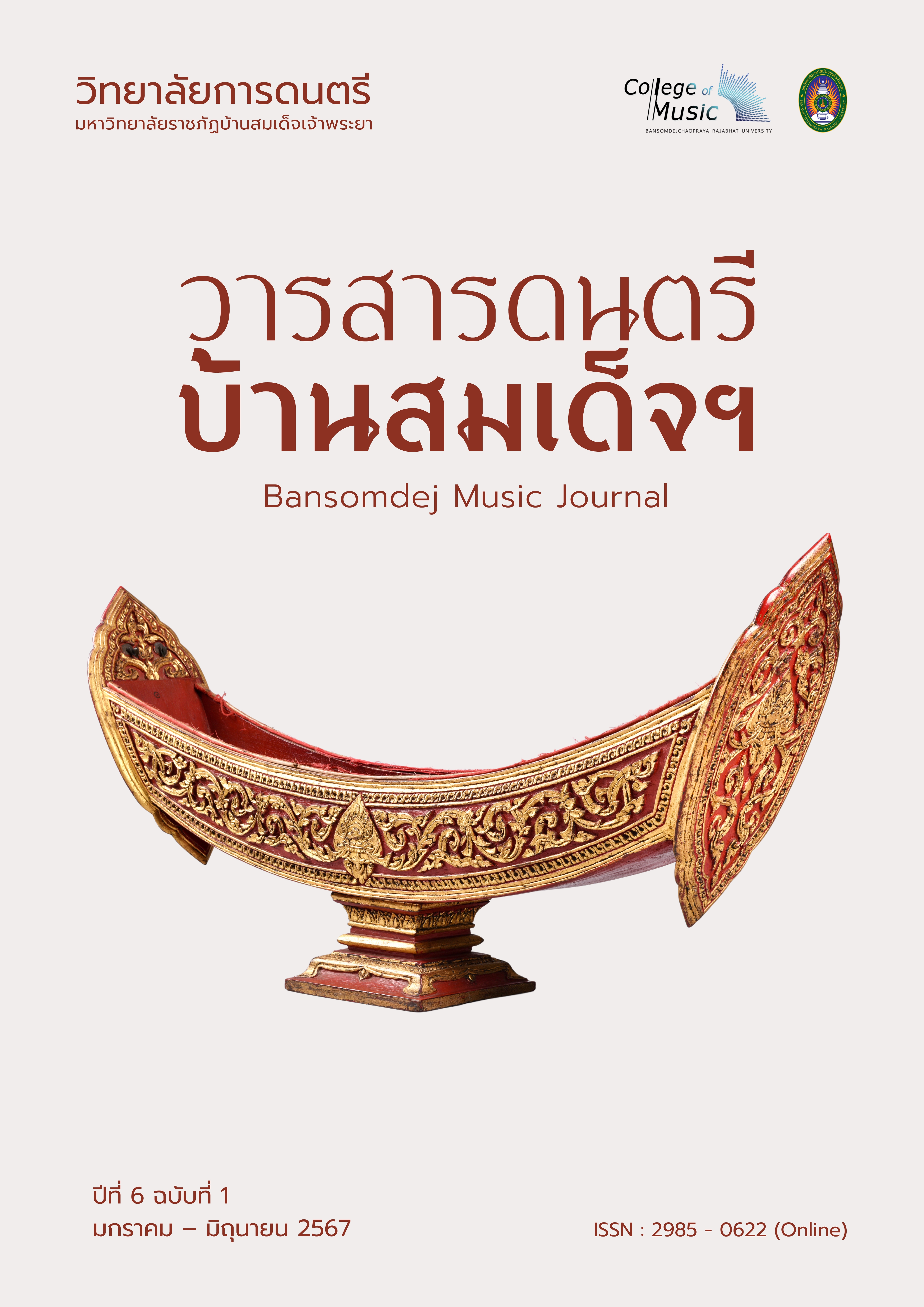การเรียนรู้เสียงดนตรีสังเคราะห์ผ่านโอเพนซอร์ส เพื่อเสริมทักษะการเรียนรู้ตลอดชีวิต
บทคัดย่อ
บทความนี้นำเสนอการใช้โอเพนซอร์ส โปรแกรมวีซีวี แร็ค (VCV Rack) ในการเรียนรู้เสียงดนตรีสังเคราะห์ เพื่อเสริมทักษะการเรียนรู้ตลอดชีวิต ผู้เขียนอธิบายความสำคัญและการใช้งานของโปรแกรมนี้ โดยเน้นบทบาทของวีซีวี แร็ค เป็นตัวจำลองยูโรแร็ค โมดูลาร์ ซินธีไซเซอร์ (Eurorack modular synthesizer) ที่หลากหลาย ผลลัพธ์การใช้โปรแกรมวีซีวี แร็ค รวมถึงการเพิ่มความรู้ทางดนตรี ทักษะการสร้างดนตรี การส่งเสริมความคิดสร้างสรรค์ การแก้ไขปัญหา และการแบ่งปันเผยแพร่ผลงาน เพื่อเสริมความเข้าใจในความสัมพันธ์ระหว่างโมดูลและส่วนประกอบของเสียงดนตรี และเพื่อฝึกการสร้างเสียงดนตรีผ่านการเชื่อมโมดูลเข้าด้วยกัน เสริมความคิดสร้างสรรค์ การคิดวิเคราะห์และการแก้ไขปัญหา เพื่อให้ผู้ใช้สามารถสร้างเสียงดนตรีตามความต้องการของตนเองได้
เอกสารอ้างอิง
กลุ่มยุทธศาสตร์กําลังคนในระบบการอุดมศึกษา วิทยาศาสตร์ วิจัยและนวัตกรรม. (2563). รายงานการศึกษาการส่งเสริมการเรียนรู้ตลอดชีวิต (Lifelong learning) เพื่อรองรับการพลิกโฉมฉับพลันและวิกฤตการณ์โลก. กรุงเทพฯ: สำนักงานสภานโยบายการอุดมศึกษา วิทยาศาสตร์ วิจัยและนวัตกรรมแห่งชาติ.
ประยูร บุญใช้. (2561). การสังเคราะห์งานวิจัยที่ใช้รูปแบบการเรียนการสอนโดยยึดผู้เรียนเป็นศูนย์กลาง : โมเดลซิปปา (CIPPA Model) ในการจัดกิจกรรม การเรียนการสอน. วารสารวิชาการหลักสูตรและการสอน มหาวิทยาลัยสกลนคร. 10(2), 77-87.
สุบิน ไชยยะ, พฤทธิ์ ศิริบรรณพิทักษ์, ปิยพงษ์ สุเมตติกุล. (2562). ทักษะที่จำเป็นต่อการ เรียนรู้ตลอดชีวิตของนิสิตนักศึกษามหาวิทยาลัย : กรอบแนวคิดเชิงทฤษฎี. วารสารครุศาสตร์สาร จุฬาลงกรณ์มหาวิทยาลัย. 48(2), 260-279.
สำนักงานปลัดกระทรวงศึกษาธิการ. (2566). ประกาศกระทรวงศึกษาธิการ ลงวันที่ 29 ธันวาคม 2565 เรื่อง นโยบายและจุดเน้นของกระทรวงศึกษาธิการ ประจำปีงบประมาณ พ.ศ. 2567. กรุงเทพฯ: กระทรวงศึกษาธิการ.
Beans, C. (2017). Musicians join scientists to explore data through sound. Proceedings of the National Academy of Sciences, Science And Culture. 114(18), 4563-4565.
Boon, H. (2023, August). Live Coding and Music Production as Hybrid Practice. Organised Sound, Cambridge University Press. 28(2), 253–263.
Engel, J., Resnick, C., Roberts, A., & Norouzi, M. (2017). Neural Audio Synthesis of Musical Notes with WaveNet Autoencoders. Proceedings of the 34th International Conference on Machine Learning, Sydney, Australia, PMLR 70.
Flannery, M. B., & Woolhouse, M. H. (2021). Musical Preference: Role of Personality and Music-Related Acoustic Features. Music & Science. 4, 1-14.
Fox, A & Wu, J. (2022). Teaching Modular Synth and Sound Design Online During COVID-19: Maximizing Learning Outcomes Through Open- Source Software and Student-Centered Pedagogy. Conference: Audio Engineering Society (AES) Convention 151. Las Vegas. 1-10.
Gabrielli, L. (2020). Developing Virtual Synthesizers with VCV Rack. New York : Focal Press.
Graakjær, N.J. and Bonde, A. (2018), "Non-musical sound branding – a conceptualization and research overview", European Journal of Marketing. 52(7/8), 1505-1525.
Harasim, D., Schmidt, S. E., & Rohrmeier, M. (2020, January 10). Axiomatic scale theory. Journal of Mathematics and Music. 14(3), 223–244.
Hickey, M. (1997, June). The Computer as a Tool in Creative Music Making. Research Studies in Music Education. 8(1), 56–70.
Höst, M., & Oručević-Alagić, A. (2011). A systematic review of research on open source software in commercial software product development. Information & Software Technology. 53(6), 616-624.
John, M., & Yee-King, M. (2015). The use of interactive genetic lgorithms in sound design: a comparative study. Computers in Entertainment. 1(1), 1-18.
Ng, H. H. (2019). Collective Free Music Improvisation as a Sociocommunicative Endeavor: A Literature Review. Update: Applications of Research in Music Education. 37(2), 15-23.
Nolan, J., Thumlert, K., Chan, H., & Kitzmann, A. (2021). Together, Apart: Modular Sound Communities in the Age of COVID-19. Journal of Music, Health, and Wellbeing. 11(12), 1-15.
Oberholtzer, Josiah W. (2015). A Computational Model of Music Composition. Doctoral dissertation Graduate School of Arts & Sciences, Harvard University.
Plimmer, H. (2018). Making music with NSynth Super. [Online.] Available from https://www.youtube.com/watch?v=0fjopD87pyw. [27 December 2023].
Randhawa, S. (2009). Open source software and libraries. OCLC Systems & Services: International Digital Library Perspectives. 25(3), 159-169.
Richard Devine. (2023). The 11 Best Eurorack Synth Modules Of 2013. [Online.] Available from https://www.synthtopia.com/content/2013/12/. [27 December 2023].
Seker, A., Diri, B., Arslan, H., & Amasyalı, M. F. (2020). Open Source Software Development Challenges. International Journal of Open Source Software and Processes. 11(4), 1–26.
Sturm, B. L., Iglesias, M., Ben-Tal, O., Miron, M., & Gómez, E. (2019). Artificial Intelligence and Music: Open Questions of Copyright Law and Engineering Praxis. Arts 2019. MDPI Journals. 8(3), 1-15.
ดาวน์โหลด
เผยแพร่แล้ว
รูปแบบการอ้างอิง
ฉบับ
ประเภทบทความ
สัญญาอนุญาต
ลิขสิทธิ์ (c) 2024 วารสารดนตรีบ้านสมเด็จฯ

อนุญาตภายใต้เงื่อนไข Creative Commons Attribution-NonCommercial-NoDerivatives 4.0 International License.





